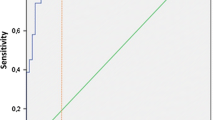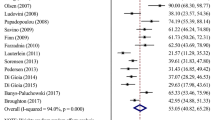Abstract
The human epidermal receptor-2/neu (HER-2/neu) oncogene encodes a transmembrane tyrosine kinase receptor. This molecule could have a diagnostic value since the extracellular domain of c-erbB-2 (HER-2) transmembrane is shed into the blood as a circulating antigen. The diagnostic value of serum HER-2/neu was calculated along with the conventional marker carbohydrate antigen 15-3 (CA15-3) and carcinoembryonic antigen (CEA) at 85th percentiles. Serum levels of breast carcinoma antigens HER-2/neu, CEA and CA15-3 were determined in 175 normal individuals and 268 malignant patients. The soluble form of serum HER-2/neu, CEA and CA15-3 was assayed by enzyme linked immunosorbent assay in control and breast cancer patients prior to treatment. Serum levels of the tested tumor markers HER-2/neu and CA15-3 and CEA were significantly higher in cancer patients compared to controls. At 85th percentile the sensitivity of HER-2/neu was 51.12 %; the specificity was 86.29 % and the overall accuracy was 64.56 %. The sensitivity of CA15-3 was 73.13 %; the specificity was 85.14 % and the overall accuracy was 77.88 %. The sensitivity of the combined testing was 82.84 %; the specificity was 73.71 % and the overall accuracy was 80.01 %. The sensitivity and the overall accuracy of combined testing were higher than those of HER-2/neu and CA15-3 testing single. The combined testing of HER-2/neu and CA15-3 can increase the sensitivity and overall accuracy of breast cancer diagnosis. The results of this study suggest that the use of multiple tumor markers may be employed as combination and at 85th percentiles to assess the prognosis.



Similar content being viewed by others
References
Akiyama T, Sudo C, Ogawara H, Toyoshima K, Yamamoto T. The product of the human c-erbB-2 gene: a 185-kilodalton glycoprotein with tyrosine kinase activity. Science. 1986;232:1644–6.
Dougall WC, Qian X, Peterson NC, Miller MJ, Samanta A, Greene MI. The neu-oncogene: signal transduction pathways, transformation mechanisms and evolving therapies. Oncogene. 1994;9:2109–23.
Mielke S, Meden H, Raab T, Wuttke W, Kuhn W. Effects of interfering and influencing factors on the analyses of p105 (c-erbB-2/HER-2) oncoprotein fragment in serum. Anticancer Res. 1997;17:3125–227.
Wu JT, Zhang P, Astill ME, Lyons BW, Wu LH. Identification and characterization of c-erbB-2 proteins in serum, breast tumor tissue, and SK-BR-3 cell line. J Clin Lab Anal. 1995;9:141–50.
Codony-Servat J, Albanell J, Lopez-Talavera JC, Arribas J, Baselga J. Cleavage of the HER-2 ectodomain is a pervanadate-activable process that is inhibited by the tissue inhibitor of metalloproteases-1 in breast cancer cells. Cancer Res. 1999;59:1196–201.
Brandt-Rauf PW. The c-erb B transmembrane growth factor receptors as serum biomarkers in human cancer studies. Mutat Res. 1995;333:203–8.
Kobayashi H, Sumimoto K, Terao T, Kawashima Y. Diagnostic value of serological tumor marker tests in patients with ovarian cancer. Nippon Sanka Fujinka Gakkai Zasshi. 1989;41:1501–6.
Visintin I, Feng Z, Longton G, Ward DC, Alvero AB, Lai Y, et al. Diagnostic markers for early detection of ovarian cancer. Clin Cancer Res. 2008;14:1065–72.
Rossi ED, Raffaelli M, Mule A, Miragilia A, Lombardi CP, Veccio FM, Fadda G. Simultaneous immunohistochemical expression of HBME-1 and galectin-3 differentiates papillary carcinomas from hyperfunctioning lesions of the thyroid. Histopathology. 2006;48:795–800.
Baskic D, Ristic P, Pavlovic S, Arsenijevic N. Serum HER-2 and CA15-3 in breast cancer patients. J BUON. 2004;9:289–94.
Gaspar MJ, Miguel JD, Garcia Diaz JD, Diez M. Clinical utility of a combination of tumour markers in the diagnosis of malignant pleural effusions. Anticancer Res. 2008;28:2947–52.
Lipton A, Leitzel K, Ali SM, Demers L, Harvey HA, Chaudri-Ross HA, et al. Serum HER-2/neu conversion to positive at the time of disease progression in patients with breast carcinoma on hormone therapy. Cancer. 2005;104:257–63.
Acknowledgments
Authors thank Indian Council of Medical Research, Delhi, India for financial support (Grant No. 3|2|2|57|2004, NCD-III).
Author information
Authors and Affiliations
Corresponding author
Rights and permissions
About this article
Cite this article
Thriveni, K., Deshmane, V., Ramaswamy, G. et al. Diagnostic Significance of CA15-3 with Combination of HER-2/neu Values at 85th Percentiles in Breast Cancer. Ind J Clin Biochem 28, 136–140 (2013). https://doi.org/10.1007/s12291-012-0288-6
Received:
Accepted:
Published:
Issue Date:
DOI: https://doi.org/10.1007/s12291-012-0288-6




